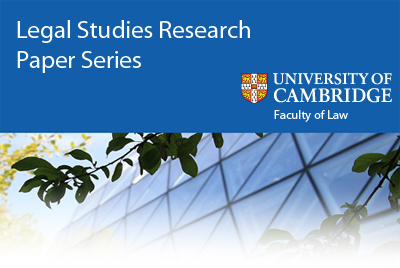 The Faculty has published Volume 4 Number 7 of the University of Cambridge Faculty of Law Legal Studies Research Paper Series on SSRN.
The Faculty has published Volume 4 Number 7 of the University of Cambridge Faculty of Law Legal Studies Research Paper Series on SSRN.
This issue includes the following articles:
Jason Pobjoy: A Child Rights Framework for Assessing the Status of Refugee Children (27/2013)
Children have always been particularly susceptible to violations of human rights. It is a sad and chilling reality that children today remain the victims of some of the most devastating examples of state-sanctioned and private exploitation, violence and torture. While the maltreatment of children cannot be regarded as a new phenomenon, increasingly children are attempting to remove themselves from the debilitating environment that circumstances have placed them in. Significant numbers of children are travelling thousands, sometimes tens of thousands of miles — often accompanied by family, sometimes not — in search of protection.
This chapter considers how international refugee law and international law on the rights of the child might be creatively aligned to respond to the reality that a child seeking international protection is both a child and a refugee. The focus of the thesis is on the capacity of the two international legal regimes to respond to the distinct needs of a refugee child in the context of the refugee status determination process.
The chapter examines three contexts — defined as ‘modes of interaction’ — where the Convention on the Rights of the Child (‘CRC’) might be engaged to assist in determining the status of a refugee child. First, the CRC may provide procedural guarantees not otherwise provided under international refugee law. Secondly, the CRC may be invoked as an interpretative aid to inform the interpretation of the Convention relating to the Status of Refugees, and in particular the Article 1 definition. Thirdly, the CRC may give rise to an independent source of status outside the international refugee protection regime. These three modes of interaction provide a ‘child rights framework’ for assessing the status of a refugee child.
Catherine Barnard: Free Movement and Labour Rights: Squaring the Circle? (23/2013)
When the Treaty of Rome was signed in 1957, its main focus was on creating a single market where free movement of goods, persons, services and capital could be ensured. It therefore regarded labour above all as a factor of production in respect of which the principle of free movement was to apply. The Treaty did contain a Title on Social Policy but its content was derisory. Subsequent Treaty amendments and the emergence of a body of secondary legislation helped to adjust this perspective on labour issues and developed what the Commission describes as the European Social Model.
However, that very social model is now under threat. The threat stems from a variety of sources: concerns about the rigidity of labour law has led to pressure for greater flexibility, the eurozone crisis has led to major reform of a number of national systems of labour law, and, for the purposes of this paper, the decisions of the Court of Justice in Viking and Laval. Against the backcloth of the eurozone crisis, the Court’s unwillingness to engage in a genuine balancing between the economic and social dimension of the EU, meant that these cases became totemic for the trade union movement of all that was bad about the EU. The Monti II proposal was intended to help address some of these problems; it was roundly rejected by the national legislatures and received the first yellow card under the new Lisbon procedure. The aim of this paper is to consider the various ways of addressing the problems generated by the decisions in Viking and Laval in the light of the Monti II proposal.
Sara Kendall & Sarah Nouwen: Representational Practices at the International Criminal Court: The Gap between Juridified and Abstract Victimhood (24/2013)
In the context of a special issue on ‘practices’ at the International Criminal Court, this article focuses on the practice of representation, and in particular on the practice of representing victims. As political and social theorists such as Pitkin and Bourdieu have argued with respect to politics, representation does not merely reflect reality, it is constitutive of it. In the ICC, two practices of victim representation have been prevalent. The first is the rather novel and widely welcomed practice of representing victims as participants in ICC proceedings. The second is the older practice of the discursive invocation of victims as the telos of international criminal law. But these two practices lead in different directions. Victim participation in court proceedings has led to the juridification of victimhood — the legal categorisation of victims — and as a result of this juridification, very few individuals are actually personally represented in the Court’s proceedings. The discursive invocation of victims as the telos of the Court’s work has created a deity-like and seemingly sovereign entity — ‘The Victims’ — that transcends all actual victims and corresponds to no individual victim in their particularity. The result of the two practices is an increasing gap between the limited role that victims play in international criminal proceedings due to the juridification of victimhood and the continued presentation of ‘The Victims’ as the raison d’être of international criminal law. The overdetermined presence of the figure of ‘The Victims’ as a rhetorical construct obscures the representative challenges faced by conflict-affected individuals in accessing the form of justice that is practiced in their (abstract) name.
Brian Sloan: The Concept of Coupledom in Succession Law (30/2013)
This paper compares the eligibility of informal cohabitants to bring claims against estates under the English Inheritance (Provision for Family and Dependents) Act 1975 and the Irish Civil Partnership and Certain Rights and Obligations of Cohabitants Act 2010. It argues that in spite of different methodologies, the two Acts cover a similar range of relationships. It also contends that both English and Irish Law nevertheless adopt an unduly narrow approach to eligibility as compared to the law in New South Wales inter alia, particularly in the light of some of the special features surrounding succession law.
Interested readers can browse the Working Paper Series at SSRN, or sign up to subscribe to distributions of the the e-journal.


 Facebook
Facebook  X/Twitter
X/Twitter  Instagram
Instagram  YouTube
YouTube  Flickr
Flickr  LinkedIn
LinkedIn